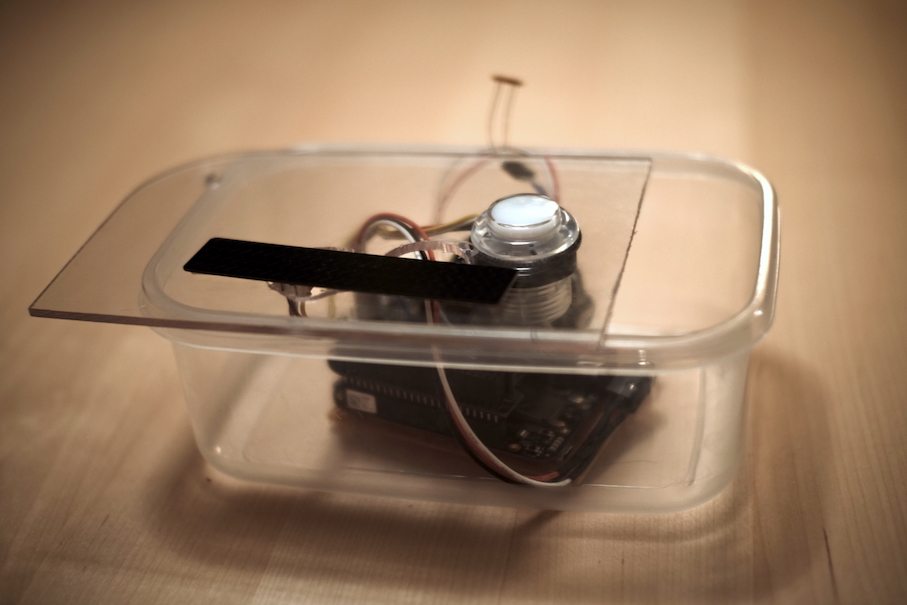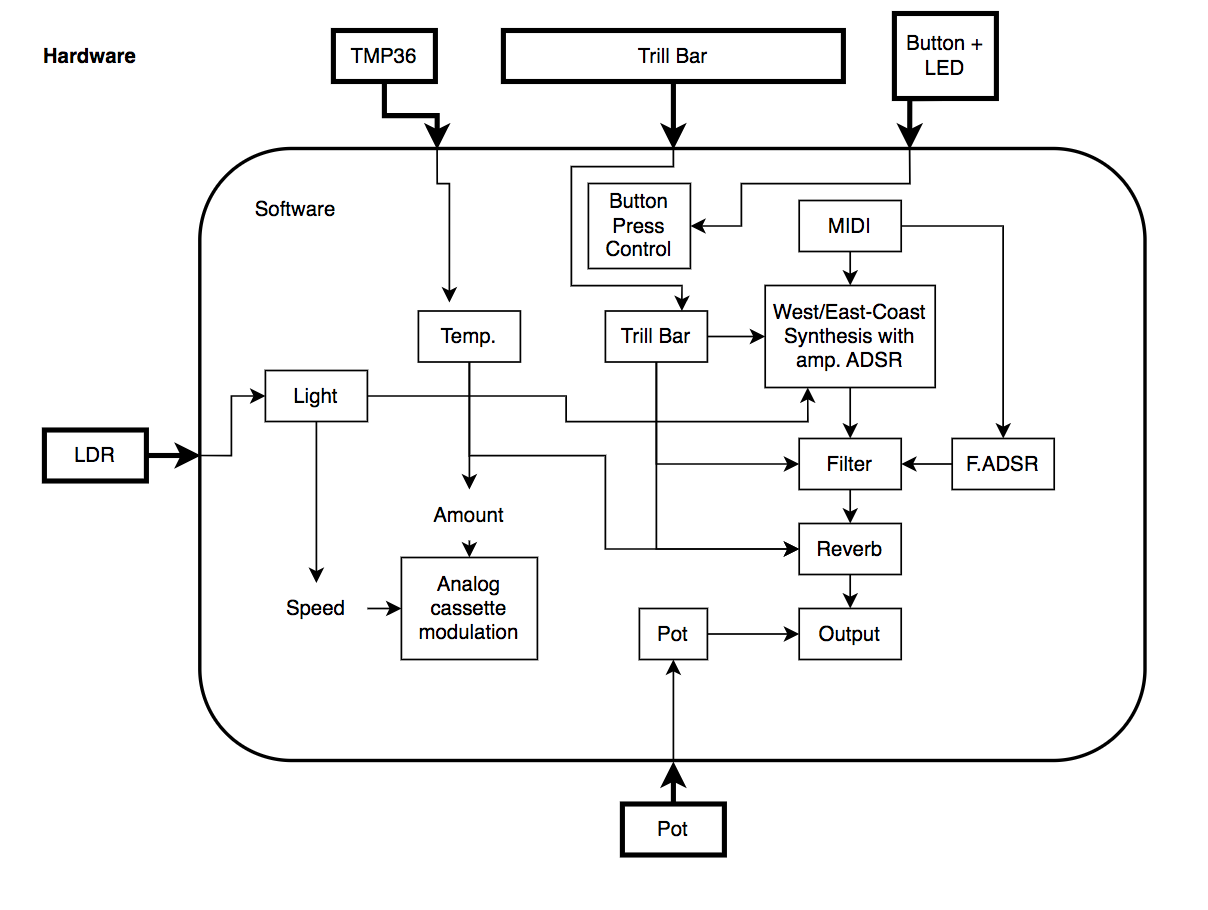SR-01

The SR-01 (SurRound-01) is a synthesizer that uses a capacitive bar (Trill Bar) to control parameters. This allows for a one-to-many mapping strategy that makes it possible to control a set of parameters using one sensor instead of many knobs and switches seen in conventional synthesizer design. In addition to this, SR-01 uses a light sensor and a temperature sensor to capture the environment in which it is being played. The idea is to introduce some degree of unexpectancy which challenges the performer to react to the output given by the instrument, as well as afford exploration of sound.
The Sound Engine
The sound engine is duophonic with separate amplitude envelopes. It has two modes for oscillation, one that is based on west coast synthesis combining wavefolding and FM inspired by the Buchla Music Easel, the other one based on a classic east coast synthesis inspired by the Moog synthesizers.
Video Demonstration
SR-01 demonstration video performing Sonata No.1 in G Minor by J. S. Bach.

Trill Bar Touchpoint Mapping
The Trill Bar can detect up to five touch points as well as touch pressure.
| Touch Points | Parameter | Pressure Parameter |
|---|---|---|
| 1 | LPF Cutoff | Filter Envelope Amount |
| 2 | Osc Mod 1 | Osc Mod 2 |
| 3 | Attack - Release/Decay | Sustain |
| 4 | Finger Spread Pan | - |
| 5 | Reverb Time | Mix |
A total of ten parameters can be accessed from the Trill Bar. An issue is the sensitivity and size of the touch strip. Sometimes it glitches and jumps rapidly back and forth between parameters, or even senses touch points that aren’t there.
Analog Cassette Modulation
I recorded a sine wave at 110 Hz onto a cassette through a Tascam 414 mkii, cut it to a loop and cooked it at eighty degrees celsius for one hour. I used a dictaphone cassette recorded to play it back through a pitch tracker patch using sigmund~. I offset the data so that the pitch was zeroed out and the only thing left was the changes in pitch info done in the heat treatment. This was recorded to a file which is being used as a modulation source to create analog modulation on pitch. For me this was a way of applying cassette tape as a sensor for capturing heat exposure over time. This can also be seen and heard live in the FAM audio demonstration.

The Environmental Sensors
LDR and TMP36 sense the surroundings and are mapped to sound parameters. The mean of the two control which style of synthesis is being used. If it is warm and bright it uses west coast inspired synthesis and for cold and dark it uses east coast inspired synthesis. Temperature is captured between -4C and 36C, and light is captured from pitch black to the equivalent of direct sunlight. The temperature controls the amount of recorded analog cassette modulation is applied to the pitch and reverb. The warmer it gets the greater the motion of atoms, which is linked to sound in the SR-01 via modulation. Light controls the speed of this modulation linked to the energy in brightness of the instruments’ surroundings.
Motion Recorder
Instead of including a set of LFOs to free the user from constantly accessing the desired parameters, the SR-01 has a way to record the motion carried out on the selected parameter. After a motion is recorded the motion data gets looped over recorded time, only interrupted by either accessing the parameter manually via the touch strip for contemporary control, or double pressing on the record button while a parameter is accessed through touch points which disables the recorded motion for that parameter. My experience so far is that this is a very efficient way of doing LFO mapping, which I think can be applied to more conventional synthesizer designs as well.
The Reverb
The reverb is based on a set of stereo delays that have unique factors of the global delay time. These delays get modulated by the cassette modulation signal to blur the repeating delays. This is an alternative way to mimic the way sound waves travel when reflected in a room without doing vector calculations of the wave in time and space in a delay mesh. The result is a quite lush and dreamy reverb in the fashion of Valhalla’s Super Massive. The quality of the reverb resolution can be set by adjusting the instance number of delay lines. The two forms of synthesis have their own reverb settings which are morphed by changing temperature.
Save/Load State
Through user testing the SR-01 received feedback that it would be nice to be able to save the state of the settings and then load it back at a later point. This draws parallels to Elektron’s way of saving and loading the settings on the Digitakt and Digitone instruments, which introduces both exploratory and performative features. For implementation it was possible to add this feature using the already implemented button. When double pressing the button with no touch points on the Trill Bar, the state is saved, whereas a single press will load the previous saved state. The integrated button LED blinks twice when saved and one long blink when loaded.
Future Improvement
Since the Trill Bar is somewhat small in size, using something like the Trill Square could be interesting. This also opens up for an XY styled parameter control and corner based mixing allowing to mix between four different sources using one motion. The current mappings of the environmental sensors offer one approach to how the sound is affected by the surroundings. This concept can be explored further for different mapping styles.
Audio Demonstration with Light and Temperature
The piece Velocity of Love by Suzanne Ciani performed on the SR-01 in dark and cold (Part 1), bright and cold (Part 2), bright and warm as well as dark and warm (Part 3).
First without reverb.
Then with reverb which is also affected by temperature.
You can download the SR-01 here. Thank you.
